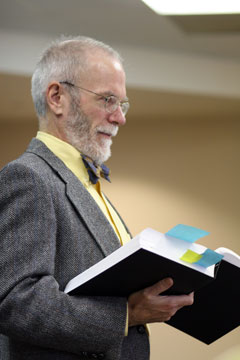Talking to the Gods |
| Printer-friendly version | Email this article |
 Professor of Classics Joe Day offers an easy way to think about the inscriptions in stone that are the focus of his book Archaic Greek Epigram and Dedication: Representation and Reperformance, published in November by Cambridge University Press. Professor of Classics Joe Day offers an easy way to think about the inscriptions in stone that are the focus of his book Archaic Greek Epigram and Dedication: Representation and Reperformance, published in November by Cambridge University Press.Consider them a way of “talking to the gods.” “These epigrams are offerings—a form of communication between humans and gods,” Day explained as colleagues gathered in Detchon Hall in November to congratulate him on the publication of this book he says was 20 years in the making. “But they’re also a form of communication between people, because others were meant to see these. “If someone came along and read one of these and liked it, that was a feather in the cap of the person who set it up. They’d think, Wow! That person really has an in with Athena, or, Wow! That person is rich, or Wow! That person has good taste and deserves some high position in our culture. “And if someone didn’t like the inscription, he’d think, Wow—what a schmuck! Like that great New Yorker cartoon of a few years ago in which the cat is standing in front of the statue of a mouse, and the cat is saying, ‘What crap!’ “So what I’m trying to figure out by studying these is what happened when people came up to look at these things—how they responded to these written offerings to the gods.” Day’s research focuses on the end of the Archaic period (circa 480 B.C) in Ancient Greek history, a time when sanctuaries were practically bursting with dedications, including finer inscriptions such as statues bearing epigrams. Other scholars have focused on the function of these inscriptions as social display, but Day’s book is the first to recover the responses of the viewers and restore them to an important place in Ancient Greek religious practice. In attempting to reconstruct how people responded to these dedications, Day says his work “is part of a general trend of imagining the lives of peoples past. “I couldn’t do my work if somebody else hadn’t studied and catalogued all the inscriptions in the Acropolis. But I want to go further; I want to try to populate those spaces with living, breathing humans who have emotional, aesthetic, religious, and social responses.” Day’s wife and Wabash colleague, Professor Leslie Day, is taking a similar approach in her most recent writing on Kavousi, Crete, as is Professor Jeremy Hartnett in his research on Pompeii and Herculaneum. Day sees such work as an important contribution to the College’s liberal arts learning. “People often toss out terms like globalization and internationalization, but thinking only in geographic, and not chronological terms,” Day says. “But it’s got to be considered both ways—you have to look back as well as out. “And putting yourself into other people’s heads is an important thing to learn. If you can’t do that, you can’t imagine what it might be like not to have health insurance or to be a woman with an unwanted pregnancy and no income. You can’t imagine what goes on in the head of the Muslim on the street in Indonesia or Damascus.” In January, Professor Day was awarded one of two Whitehead Visiting Professorships at the American School of Classical Studies at Athens for the 2011/12 academic year. The position will allow him to continue his research on the Greek epigram while teaching a seminar on the subject. Day is the second in his family to receive a Whitehead Professorship. His wife, Wabash Professor of Classics Leslie Day, earned the award in 2005.
|
